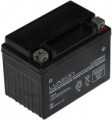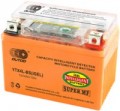Electrolyte type
Among car batteries there are
lead-acid (SLA), advanced
lead-acid (EFB),
absorbent glass mat (AGM),
gel (GEL),
lithium-ion (Li-Ion) and
LFP (LiFePO4).
More about them:
— SLA (lead-acid). In a broad sense, the vast majority of modern car batteries are lead-acid, since their design is based on a combination of electrodes made of lead compounds and an electrolyte, the role of which is played by sulfuric acid diluted with water. Specifically, in this case, we mean the classic type of batteries that use a regular liquid electrolyte. Their widespread use is due to the simplicity of the design and low cost in combination with good capacity and starting current indicators (see below), as well as resistance to low temperatures (compared to other types of batteries).
— EFB (lead-acid). An improved subtype of lead-acid batteries with a longer service life, a high degree of safety and a virtually maintenance-free design. The abbreviation EFB stands for Enhanced Flooded Battery, which means "Improved battery with liquid electrolyte". A distinctive feature of EFB technology is thick plates made of pure lead without any impurities. The positive plates in the battery design are wrapped in special "bags" made of microfiber, which absorbs and holds the liquid electrolyte
.... As a result, intensive shedding of the active substance is prevented and the sulfation process during deep discharge of the battery is significantly slowed down. And due to the homogeneous structure of the electrolyte (mixed during natural movement of the car), the overall service life of EFB lead-acid batteries is increased and the charging speed is increased.
— AGM (absorbent glass mat). A type of lead-acid batteries, also known by the abbreviation AGM. The main design feature is described by the name itself: in such batteries, the space between the plates is filled not with liquid, but with glass cloth — microporous plastic, which is impregnated with the electrolyte itself (an aqueous solution of sulfuric acid). This design has a number of advantages over the classic one: for example, AGM batteries do not require maintenance (see "Maintenance") and practically do not emit gases during charging (the resulting oxygen and hydrogen recombine inside the battery itself), are resistant to shaking and are well suited for start-stop systems (see "Start-stop support"). Their disadvantages are high sensitivity to increased voltage during charging, the need for a special charger (regular ones are not suitable), and also the high cost.
— GEL (gel). One of the subtypes of lead-acid batteries, in which the electrolyte is not liquid, but thickened to a gel-like state. This design provides a number of advantages compared to the classic version (see above): a greater number of charge-discharge cycles (and therefore a longer service life); minimum leakage of electrolyte and associated gases; no need for maintenance (see "Maintenance"); resistance to deep discharges and temperature fluctuations, etc. On the other hand, GEL batteries are noticeably more expensive.
— Li-Ion (lithium-ion). Lithium-ion technology was originally used in batteries for portable gadgets such as mobile phones, but such batteries are becoming more and more widely used. The first type of transport to use Li-Ion technology were motorcycles. The advantages of such batteries over more traditional varieties include smaller dimensions and weight, the ability to produce high starting currents and charge with high currents (the latter significantly reduces the charging time), as well as a large number of charge-discharge cycles and a long shelf life. In addition, Li-Ion batteries contain a minimum of harmful substances, do not use acids or heavy metals, and some models are positioned as completely harmless to the environment. The main disadvantage of lithium-ion batteries is their very “biting” price.
— LiFePO4 (LFP). Such batteries are actually a modification of lithium-ion batteries (see the corresponding section), developed to eliminate some of the shortcomings of the original technology. They are notable, first of all, for their high reliability and safety: the probability of a battery “explosion” during overload is reduced to almost zero, and in general, LiFePO4 cope with high peak loads without problems. In addition, they are quite resistant to cold and maintain the operating voltage almost until the very discharge. The main disadvantage of this type is a slightly lower capacity.Starting power (EN)
The starting power of the battery, measured according to the EN standard (the unified standard of the European Union). According to this standard, the starting power is the maximum power that the battery can deliver for 30 seconds at an electrolyte temperature of -18 °C without the voltage dropping below a certain level (for standard 12 V batteries - not lower than 7.2 V). The term "starting" appeared because this operating mode is similar to starting an engine, when the battery has to deliver a high-power power to the starter for a short time.
The recommended starting power value is generally related to the weight category of the vehicle: the heavier it is, the more powerful the power usually needed to start it. And many manufacturers directly indicate the recommended values in the characteristics of a particular vehicle model. If the battery is purchased as a replacement, the general rule is: its starting power should be no less than that of its predecessor.
Note that in practice, starting power designations may be encountered according to 3 more standards: SAE (USA), DIN (Germany) and TU (GOST 959-91). The first is almost identical to EN, and DIN and TU are quite easy to translate into EN and vice versa: they are similar to each other, and each of them gives a number approximately 1.7 times smaller than NE. That is, for example, to replace a 200 A battery according to TU, you should look for a model with a power of at least 340 A (200 * 1.7) according to EN.
Charge indicator
Has
a charge indicator on the battery.
Such an indicator displays the current charge level and allows you to generally assess the state of the battery literally at a glance, without additional actions and diagnostic equipment. In some models of serviceable batteries, the indicator can signal not only the need for charging, but also the need to add water to the electrolyte (for more details, see "Maintenance").

